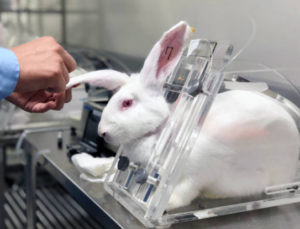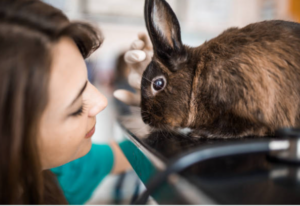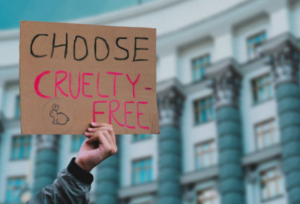The High Cost of Beauty Testing

In the ever-evolving world of beauty and cosmetics, the pursuit of perfection often comes at a price that extends beyond the price tag on the products themselves. One of the darker aspects of the beauty industry is the use of animals, particularly rabbits, in eye irritation tests to assess the safety of cosmetic and personal care products. This practice, while historically common, has faced increasing scrutiny and criticism from animal rights activists and ethical consumers. In this comprehensive blog, we’ll delve into the world of eye irritation tests on rabbits, exploring the methods, ethical concerns, and the growing movement towards cruelty-free beauty.
Animal testing, including eye irritation tests, has been a longstanding practice in the cosmetics industry. Rabbits, due to their docile nature and large eyes, became the primary subjects for these tests. The Draize test, developed in the 1940s, involves applying a substance to the eyes or skin of a restrained rabbit to observe any adverse reactions. Unfortunately, this method often leads to severe discomfort, pain, and sometimes permanent damage to the rabbits’ eyes.
While some argue that animal testing has contributed to the development of safe and effective cosmetic products, the ethical implications have sparked a global conversation about the need for more humane alternatives.
The Draize Test and Its Ethical Implications
1. Invasive Nature of the Test:
The Draize test involves the application of substances directly into the eyes of restrained rabbits. This invasive procedure is not only uncomfortable but can cause significant distress to the animals. The rabbits are often immobilized in stocks or other devices to prevent them from rubbing their eyes and interfering with the test, further exacerbating their stress.
2. Lack of Analgesics or Anesthetics:
One of the stark ethical concerns is the absence of pain relief for the rabbits undergoing the Draize test. The discomfort and pain experienced by the animals are exacerbated by the lack of analgesics or anesthetics, as administering these could potentially interfere with the test results.
3. Limited Environmental Stimulation:
The rabbits used in Draize tests are typically confined to restrictive cages during the testing period. This lack of environmental stimulation can lead to boredom, frustration, and psychological distress. These conditions not only compromise the well-being of the animals but may also impact the reliability of the test results due to stress-related variables.
4. Subjectivity in Observations:
The evaluation of test results in the Draize test is subjective, relying on human observers to interpret the rabbits’ reactions. This subjectivity can lead to variability in the assessment, and concerns have been raised about the reliability of results, questioning the test’s ability to accurately predict human responses to cosmetic products.
5. Poor Correlation with Human Reactions:
Despite its historical prevalence, the Draize test has been criticized for its limited ability to correlate with human reactions accurately. The anatomical, physiological, and biochemical differences between rabbit and human eyes contribute to a lack of predictive validity. Substances that may cause irritation in rabbits might not necessarily elicit the same response in humans, raising questions about the relevance of the test in ensuring human safety.
9. Corporate Responsibility:
Acknowledging the ethical concerns associated with the Draize test, responsible corporations within the beauty industry are taking proactive steps. Some have shifted away from animal testing altogether, committing resources to the development and validation of alternative testing methods. This reflects a broader trend of corporate responsibility and responsiveness to evolving consumer values.

Growing Opposition and Alternatives
In recent years, a groundswell of opposition against animal testing has surged globally. Governments are increasingly recognizing the ethical concerns and public outcry, leading to legislative actions against cosmetic testing on animals. The European Union has been a trailblazer in this movement, implementing a comprehensive ban on animal testing for cosmetic products in 2013. This ban not only applies to testing within the EU but also extends to products imported from elsewhere, enforcing a strict prohibition on marketing products tested on animals.
Beyond the EU, other countries have also committed to putting an end to animal testing in cosmetics. India and Israel, for instance, have implemented similar bans, aligning themselves with the ethical principles that prioritize the well-being of animals. These legislative actions represent a growing international consensus on the need to move away from outdated and inhumane testing practices.
Technological progress has been a driving force in providing viable alternatives to traditional animal testing. In vitro testing, which involves using human cells and tissues, is gaining prominence as a humane and scientifically sound alternative. This method not only eliminates the need for testing on animals but also offers results that are often more accurate in predicting human responses. Human-on-a-chip models and organoids are some of the innovative techniques within in vitro testing, providing a sophisticated understanding of how products interact with human biology.
In tandem with in vitro testing, sophisticated computer models are emerging as powerful tools in the quest for alternatives to animal testing. These models utilize advanced algorithms to simulate the interactions of cosmetic and personal care products with human tissues. Not only are these computer models more humane, but they also have the potential to provide more precise and reliable data, contributing to the refinement and improvement of cosmetic formulations.
The growing opposition to animal testing is notably reflected in the diminishing reliance on the Draize test. Once considered the gold standard for assessing eye irritation, the Draize test’s ethical concerns and limitations in predicting human responses have prompted a shift towards more progressive and humane methodologies. This reduction in reliance is evident in the increased adoption of alternative testing methods by ethical and forward-thinking beauty brands.
The Cruelty-Free Movement
The cruelty-free movement represents a powerful and dynamic shift in consumer values within the beauty industry. Increasingly informed and conscientious consumers are actively seeking products that align with their ethical beliefs. Social media, online forums, and beauty influencers play pivotal roles in disseminating information about cruelty-free practices, empowering consumers to make informed choices that resonate with their values.
To cater to the demand for cruelty-free products, various certification programs have emerged, providing consumers with a reliable way to identify brands that abstain from animal testing. Two prominent certifications are PETA’s Beauty Without Bunnies and the Leaping Bunny program, both of which rigorously verify and endorse products that meet their cruelty-free criteria. Brands proudly display these certifications, building trust and transparency with consumers.
The cruelty-free movement has gained considerable traction through endorsements by celebrities and influencers. High-profile figures use their platforms to advocate for ethical beauty choices, encouraging their followers to support cruelty-free brands. This endorsement not only amplifies the message but also contributes to the normalization of cruelty-free practices, making them aspirational and trendy.
In addition to consumer-driven change, legislation has played a crucial role in curbing the use of animals in cosmetic testing. The United States, for example, has seen progress at the state level, with several states passing laws that restrict or ban cosmetic testing on animals.
The Humane Cosmetics Act, a federal bill introduced in the U.S., aims to phase out and eventually prohibit cosmetic animal testing. If passed, this legislation would align the U.S. with the growing global trend towards cruelty-free beauty practices.

The Beauty Industry’s Response
Acknowledging the concerns raised by consumers and the ethical implications of animal testing, many beauty brands are reevaluating their testing practices. Several well-known companies have made public commitments to go cruelty-free and are investing in alternative testing methods.
L’Oreal, one of the largest beauty companies globally, has been working to develop and implement alternative testing methods. The company has invested in tissue engineering and has committed to a substantial reduction in animal testing. Similarly, The Body Shop has long been a champion of cruelty-free beauty and has actively campaigned against animal testing.
While significant progress has been made in reducing and eliminating animal testing in the beauty industry, challenges remain. Some argue that certain tests, particularly those related to complex reactions and long-term effects, still require the use of animals. Balancing the need for product safety with ethical considerations remains a complex and ongoing challenge for the industry.
The development and validation of alternative testing methods continue to be areas of focus for researchers and scientists. As technology advances, it is anticipated that more accurate, reliable, and humane testing methods will be adopted globally, further reducing the reliance on animal testing.

The use of rabbits in eye irritation tests for cosmetics is a practice rooted in history, but the growing awareness of its ethical implications is reshaping the beauty industry. The Draize test, once a standard procedure, is now facing increased criticism, and consumers are demanding change. The cruelty-free movement, advancements in alternative testing methods, and legislative initiatives are collectively pushing the beauty industry towards a more compassionate future.
As consumers, our choices play a pivotal role in driving this transformation. By supporting cruelty-free brands, advocating for legislative change, and staying informed, we can contribute to a beauty industry that values both the pursuit of perfection and the well-being of all living beings. Together, we can redefine beauty standards and ensure that the cost of beauty no longer includes the suffering of innocent creatures.

